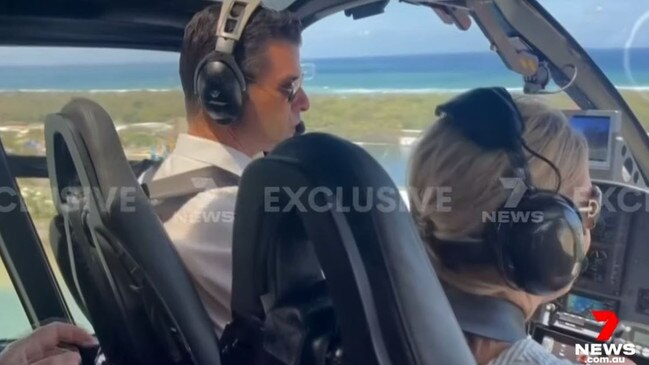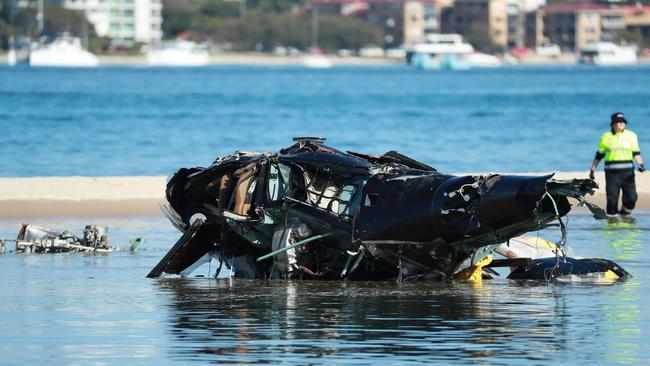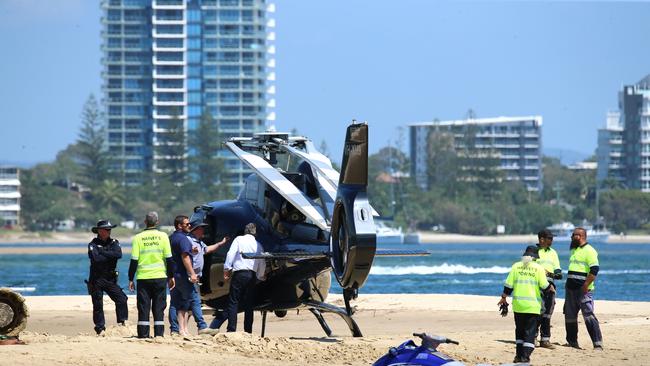Series of unfortunate events behind Sea World chopper disaster
Police have spoken to the surviving pilot from the Sea World helicopter disaster as aviation experts say a combination of unfortunate events were likely behind the mid-air collision.
QLD News
Don't miss out on the headlines from QLD News. Followed categories will be added to My News.
- WATCH: Shock video from inside chopper collision
- Eerie premonition of boatie who rushed to chopper crash
Phave spoken to the pilot whose “remarkable” landing allowed six people to walk away from the Gold Coast helicopter disaster which claimed four lives.
Sea World Helicopters pilot Michael James, 52, has been recovering in hospital since undergoing surgery following Monday’s horrific accident on the Gold Coast Broadwater.
Police have now spoken to all those who were aboard the helicopter which managed to somehow land safely on a sand bank after the crash, including Mr James and two New Zealand tourists who also remain in hospital.
It comes as aviation experts deem the Sea World helicopter collision a true tragedy, saying the experienced pilots may have encountered a combination of unfortunate, ill-timed events prior to the fatal mid-air crash.
Mr James, 52, and fellow pilot Ash Jenkinson, 40, were each flying tour helicopters on the Gold Coast when they collided in the air over the Broadwater about 2pm Monday.
Mr Jenkinson and three passengers died, while three others were rushed to hospital with serious injuries.
The front section of Mr James’ helicopter was torn off on impact, but he was able to land on a nearby sandbank, saving all six of his passengers.

The two Eurocopter EC130 choppers were newly registered to Sea World Helicopters and are mainly used for five-minute joy flight tours, showcasing birds eye views of the theme parks’ ocean surrounds.
Aviation experts Geoffrey Thomas of Airline ratings and Keith Tonkin, managing director of Aviation Project, said the pilots would have had an airtight communication system involving radio calls and situational awareness checks.
“My understanding is Sea World Helicopter tours do this often, there’s multiple helipads and procedures that accommodate multiple aircraft coming and going, usually they have radio call outs, ‘see and avoids,’” Mr Tonkin said.

“They call it situational awareness.
“It could have been something like the sun glare angle or an (internal) flight issue.
“If they did have awareness of each other, how they could have collided is what the investigators will find.”
“It would have been a ‘see and be seen’ basis – they would have had radio contact, saying they’re coming in to land, they would have seen each other, it’s very professional (tours), and they’re excellent helicopters,” Mr Thomson said.
“There’s a variety of scenarios.”

In respect of the actual cause of the accident he said: “That’s something we won’t know until the post-mortems are complete.”
Registration records show the VH-XKQ helicopter piloted by Mr Jenkinson had been recently imported from overseas and registered to Sea World Helicopters on November 2, 2022, while the VH-XH9 flown by Mr James was registered on November 3.
The two helicopters involved in the collision were designed to have pilots sit on the left hand side, with up to two passenger seats on the right and a further four in the back.
At least five EC130 helicopters are currently registered to Sea World Helicopters, containing both left and right hand pilot seating.

Both Mr Thomas and Mr Tonkin said it was highly unlikely that left-hand seating would obscure a pilot’s view as it was industry standard to be trained to fly on either side of an aircraft.
“They are totally used to flying left or right, that’s the way they trained and the way helicopters are flown, so I don't think that’s a factor (of the crash),” Mr Thomas said.
Mr Tonkin, who served 15 years in the Royal Australian Air Force, said he’d flown in both seats of an aeroplane and that it rarely had negative impacts on piloting conditions.
“Sometimes you have to think a bit harder if you’re changing seat positions,” he said.
“When you’re in the left hand seat it’s obviously easier to see out the left hand side compared to looking across the cockpit, that’s just logistic due to being physically seated on the left side.
“With people sitting next to you, that (view) might be obscured but helicopters have a big bubble window specially designed to allow you to see.
“And whether you’re sitting in the left or right hand seat you’d know about any sight restrictions and you’d accommodate those.”

The Australian Transport Safety Bureau (ATSB) is currently investigating the crash and said it was too early to start speculating.
“What we’ll have a look at now is what were the processes and procedures in place operating out of Sea World? Were they followed? Were they sufficient? What were those processes in place to protect helicopters, particularly in those phases of flight?” ATSB Chief Commissioner Angus Mitchell said.
“But exactly why this occurred, what the range of visibility for both the pilots, what was happening inside the cabins at the time – they are the things that will help us piece together potentially what might have been a contributing factor here.”
Mr Thomas said the events leading up to the crash were likely a tragic set of ill-timed circumstances.
“You have to be a damn good pilot to be flying one of those things,” Mr Thomas said.
“These guys are very professional. Sure you have a series of (tour) rotations, that is what they (helicopters) are designed for, and pilots are used to and it increases their skill level.
“A combination of events that have conspired to end those lives.
“Bottom line is it should have never happened.”




